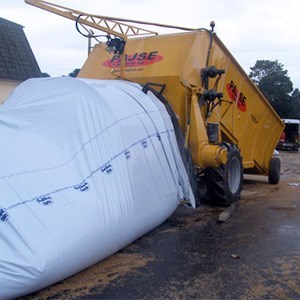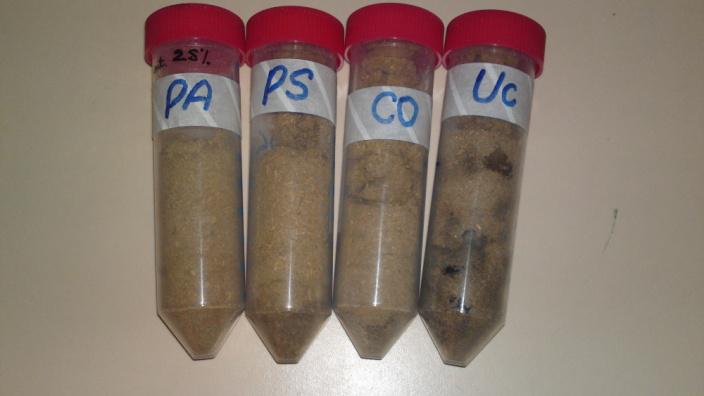Facts:
Funded by The Swedish Research Council for Environment, Agricultural Sciences and Spatial Planning (Formas), and the MicroDrivE-programme.

In this project we investigate the application of yeasts for biopreservation of moist biomass. This technology has been used for a long time for an energy saving storage of animal feed biomass.
In this project we investigate the application of yeasts for biopreservation of moist biomass. This technology has been used for a long time for an energy saving storage of animal feed biomass.
We are continuing working in this field determining the impact of this technology on the hygienic and nutritional quality of the feed.
Recently we applied biopreservation to establish a novel technology, Integrated Storage and Pretreatment (ISP) for biofuel production. On cereal grain, improved starch degradation was observed after moist storage, finally resulting in an increased ethanol yield from the material.
Currently we are extending the ISP-concept on lignocellulose (LC), a complex material consisting of polysaccharides and lignin. Efficient biofuel production from its polysaccharides requires energy consuming, costly, and inhibitor releasing mechanical, thermochemical and enzymatic pretreatments. ISP can decrease the demand for pretreatment intensity and improve the ethanol production, with ISP-treated wheat straw we obtained up to 35% more ethanol than from a dry control. Inhibition of moulds is another critical parameter of ISP.

Wheat straw powder preserved with Wickerhamomyces anomalus (PA), Scheffersomyces stipitis (PS), both yeasts (CO), and an un-inoculated control (Uc). Strong mould growth was observed in the control. Photo: M.R. Tabassum.
Currently we are developing ISP for woody materials, using biocontrol yeasts and or yeasts with capabilities to degrade biopolymers (e.g. Wickerhamomyces anomalus or Scheffersomyces stipitis).
Borling Wellin J, Lyberg K, Passoth V, Olstorpe M (2015). Combined moist airtight storage and feed fermentation of barley by the yeast Wickerhamomyces anomalus and a lactic acid bacteria consortium. Front Plant Sci 6, 270
Theuretzbacher F, Blomqvist J, Lizasoain J, Klietz J, Potthast A, Horn SJ, Nilsen PJ, Gronauer A, Passoth V, Bauer A (2015). The effect of a combined biological and thermo-chemical pretreatment of wheat straw on energy yields in coupled ethanol and methane generation. Bioresource Technol 194, 7-13
Mogodiniyai Kasmaei K, Passoth V, Spörndly R, Udén P (2015). A new sterilization and inoculation method in silage research. Gras and Forage Science 70, 668-690
Passoth V (2015). Yeasts previously included in the genus Pichia. In: R Russell M Paterson (ed.): Molecular Biology of Food and Water Borne Mycotoxigenic and Mycotic Fungi of Humans. CRC press, Taylor & Francis Group, Boca Raton, London, New York. pp. 463-481
Blomqvist J, Leong SL, Sandgren M, Lestander L, Passoth V (2014). Temperature-dependent changes in the microbial storage flora of birch and spruce sawdust. Biotechnol Appl Biochem 61, 58-64
Passoth V, Rizwan MR, Nair HA, Olstorpe M, Tiukova I, Ståhlberg J. 2013. Enhanced ethanol production from wheat straw by integrated storage and pre-treatment (ISP). Enzyme Microb. Technol. 52: 105-110
Schneider J, Rupp O, Trost E, Jaenicke S, Passoth V, Goesmann A, Tauch A, Brinkrolf K. 2012. Genome sequence ofWickerhamomyces anomalus DSM 6766 reveals genetic basis of biotechnologically important antimicrobial activities. FEMS Yeast Res. 12: 382-386
Olstorpe M, Schnürer J, Passoth V. 2012. Growth inhibition of various Enterobacteriaceae species by the yeast Hansenula anomala during storage of moist cereal grain. Appl Environ Microbiol. 78: 292-294
Wuczkowski M, Passoth V, Turchetti B, Andersson AC, Olstorpe M, Laitila A, Theelen B, van Broock M, Buzzini P, Prillinger H, Sterflinger K, Schnürer J, Boekhout T, Libkind D. 2011. Description of Holtermanniella takashimae sp. nov.,Holtermanniella gen. nov. and proposal of the order Holtermanniales to accommodate Tremellomycetous yeasts of theHoltermannia clade. Int J Syst Evol Microbiol 61: 680-689
Olstorpe M, Passoth V. 2011. Pichia anomala in grain biopreservation. Antonie van Leeuwenhoek 99, 57-62
Passoth V, Olstorpe M, Schnürer J. 2011. Past, present and future research directions with Pichia anomala. Antonie van Leeuwenhoek 99, 121-125
Olstorpe M, Schnürer J, Passoth V. 2010. Microbial changes during storage of moist crimped cereal barley grain under Swedish farm conditions. Anim Feed Science Technol. 156, 37–46
Olstorpe M, Borling J, Schnürer J, Passoth V. 2010. Pichia anomala yeast improves feed hygiene during storage of moist crimped barley grain under Swedish farm conditions. Anim Feed Science Technol. 156, 47-56
Olstorpe M, Axelsson L, Schnürer J, Passoth V. 2010. Effect of starter culture on feed hygiene and microbial population development in cereal grain mix fermented with wet wheat distillers’ grain. J Appl Microbiol. 108, 129–138
Passoth V, Eriksson A, Sandgren M, Ståhlberg J, Piens K, Schnürer J. 2009. Airtight storage of moist wheat grain improves bioethanol yields. Biotechnol Biofuels 2, 16
Passoth V, Andersson AC, Olstorpe M, Theelen B, Boekhout T, Schnürer J. 2009. Cryptococcus cerealis sp. nov. a psychrophilic yeast species isolated from fermented cereals. Antonie van Leeuwenhoek 96, 635–643
Olstorpe M, Schnürer J, Passoth V. 2009. Screening of yeast strains for phytase activity. FEMS Yeast Res. 9, 478-488
Olstorpe M, Lyberg K, Lindberg JE, Schnürer J, Passoth V. 2008. Population diversity of yeasts and lactic acid bacteria in pig feed fermented with whey, wet wheat distillers' grains, or water at different temperatures. Appl Environ Microbiol 74, 1696-1703
Lyberg K, Olstorpe M, Passoth V, Schnürer J, Lindberg JE. 2008. Microbiological and nutritional characterisation of pig feed fermented with whey, wet wheat distillers’ grain or water in different temperatures. Animal Feed Sci Technol. 144, 137-148
Fredlund E, Beerlage C, Melin P, Schnürer J, Passoth V. 2006. Oxygen and carbon-source regulated expression of PDC andADH genes in the respiratory yeast Pichia anomala. Yeast 23, 1137-1149
Passoth V, Fredlund E, Druvefors UÄ, Schnürer J. 2006. Biotechnology, physiology and genetics of the yeast Pichia anomala. FEMS Yeast Res. 6, 3-13
Druvefors UÄ, Passoth V, Schnürer J. 2005. Nutrient effects on biocontrol of Penicillium roqueforti by Pichia anomala J121 in cereal grain. Appl Environ Microbiol. 70, 5905-5911
Fredlund E, Blank LM, Schnürer J, Sauer U, Passoth V. 2004. Oxygen and glucose dependent regulation of central carbon metabolism in Pichia anomala. Appl Environ Microbiol 70, 5905-5911
Fredlund E, Druvefors UÄ, Olstorpe M, Passoth V, Schnürer J. 2004. Influence of ethyl acetate production and ploidy level on the anti-mould activity of Pichia anomala. FEMS Microbiol Lett 238, 133-137
Funded by The Swedish Research Council for Environment, Agricultural Sciences and Spatial Planning (Formas), and the MicroDrivE-programme.
volkmar.passoth@slu.se, 018-673380